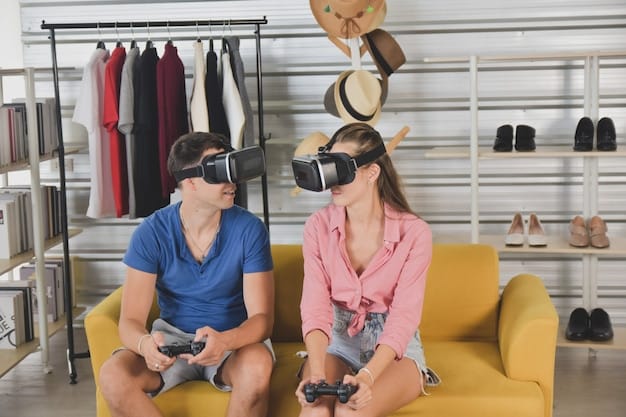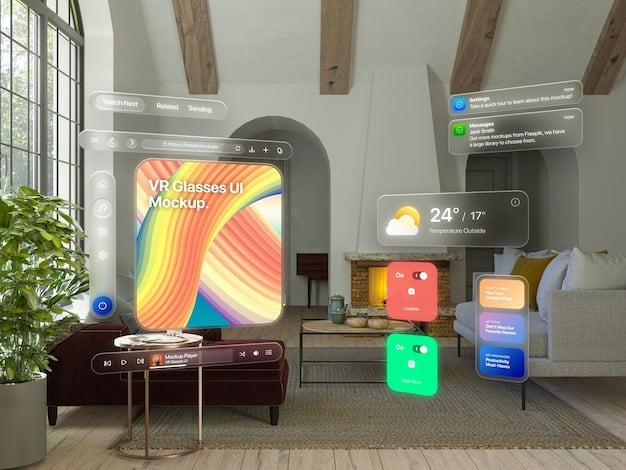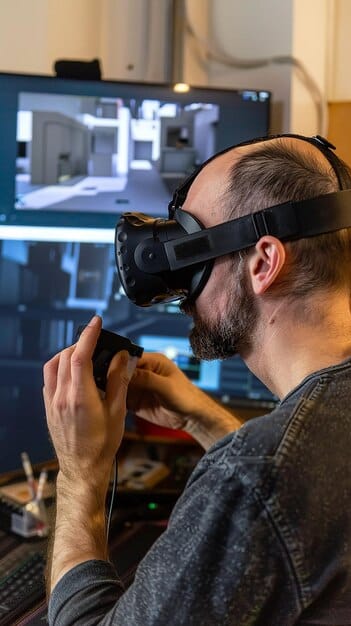The Future of Customer Experience: AR and VR Revolution

The future of customer experience is here, driven by augmented reality (AR) and virtual reality (VR). These technologies are reshaping the customer journey, offering immersive and personalized interactions that enhance engagement and satisfaction.
Are you ready to explore the future of customer experience is here? Augmented Reality (AR) and Virtual Reality (VR) are no longer futuristic concepts; they’re actively transforming how businesses interact with their customers. This dynamic shift is creating more immersive, personalized, and engaging journeys.
Let’s dive into how AR and VR are revolutionizing the customer experience, and what this means for businesses. Discover the power of the future of customer experience is here.
Exploring the transformative power of AR and VR in customer experience
Augmented Reality (AR) and Virtual Reality (VR) technologies are rapidly reshaping the landscape of customer experience. By integrating digital content into the real world or creating entirely immersive digital environments, these technologies offer unprecedented opportunities to engage with customers in innovative and meaningful ways.
Enhanced Engagement through AR
AR enhances customer engagement by overlaying digital information onto the real world. This allows customers to interact with products and services in a more intuitive and informative manner.
- Virtual Try-Ons: Customers can use AR to virtually try on clothing, accessories, or makeup before making a purchase, enhancing their confidence and reducing returns.
- Interactive Product Demos: AR can provide interactive demonstrations of products, showcasing features and benefits in a visually compelling way.
- In-Store Navigation: AR can assist customers in navigating physical stores, guiding them to products and providing additional information.
The integration of AR into customer experience strategies not only enhances engagement but also provides valuable data insights into customer preferences and behaviors, allowing businesses to tailor their offerings and improve customer satisfaction.

VR and AR: redefining retail customer experiences
The retail industry is undergoing a massive transformation thanks to VR and AR. These experiences go beyond traditional methods creating immersive and compelling customer experiences.
Virtual Shopping Experiences
VR enables customers to enter virtual stores from the comfort of their homes, offering a realistic and engaging shopping experience.
- Immersive Store Environments: VR can create virtual stores that replicate the look and feel of physical stores, complete with product displays, music, and ambiance.
- Personalized Shopping Assistants: VR can provide virtual shopping assistants that guide customers through the store, answer questions, and offer personalized recommendations.
- Product Visualization: VR allows customers to visualize products in detail, examining them from all angles and in different settings.
By offering immersive and personalized shopping experiences, VR helps retailers differentiate themselves from competitors and build stronger relationships with their customers. These technologies also enhance retention and satisfaction within the overall customer base.
The Future of Customer Experience is Here: How Augmented Reality (AR) and Virtual Reality (VR) are Transforming the Customer Journey
The customer journey is witnessing a seismic shift thanks to the integration of augmented and virtual reality. These technologies are not just novelties; they are integral tools for creating more engaging, informative, and personalized customer interactions.
AR and VR in Product Demonstrations and Training
AR and VR offer unique opportunities for product demonstrations and training, providing customers with hands-on experiences that were previously impossible.
Through these capabilities the future of customer experience is here, offering customers a deeper understanding and appreciation of products and services, leading to higher satisfaction and advocacy.

Enhancing customer support with AR and VR Technologies
AR and VR are revolutionizing customer support by enabling more effective and efficient problem-solving. These technologies provide support agents with enhanced tools to assist customers remotely, leading to faster resolution times and higher customer satisfaction.
Remote Assistance via AR
AR enables support agents to provide remote assistance by overlaying digital information onto the customer’s view of the problem.
By providing remote assistance through AR, support agents can resolve issues more quickly and effectively, reducing the need for on-site visits and improving customer satisfaction. The use of VR in customer support is evolving, but the potential for simulated training environments for support staff and immersive diagnostic tools is immense.
Personalization through AR and VR
One of the most significant advantages of AR and VR is their ability to personalize the customer experience. By tailoring interactions to individual preferences and needs, businesses can create more engaging and meaningful relationships with their customers.
Customized Experiences
AR and VR enable businesses to create customized experiences that cater to individual customer preferences.
By personalizing the customer experience through AR and VR, businesses can foster a sense of connection and loyalty, leading to higher customer retention rates and increased brand advocacy. Businesses can leverage AR and VR to offer unique experiences that set them apart from competitors leading to major benefits for customer relations.
Overcoming the challenges of AR and VR implementation
While the future of customer experience is here is exciting, there are still significant hurdles to overcome before these technologies can be widely adopted. Addressing these challenges is essential for businesses looking to leverage AR and VR to enhance the customer journey.
- Lack of Awareness: Many customers are still unaware of the capabilities and benefits of AR and VR.
- High Costs: Developing and deploying AR and VR experiences can be expensive, particularly for small businesses.
- Technical Limitations: Current AR and VR technologies still have limitations in terms of processing power, display resolution, and battery life.
By addressing these challenges head-on, businesses can pave the way for wider adoption of AR and VR technologies, unlocking their full potential to transform the customer experience.
| Key Point | Brief Description |
|---|---|
| 🚀Enhanced Engagement | AR elevates customer interaction through virtual try-ons and interactive demos. |
| 🛒Retail Revolution | VR redefines retail with immersive stores and personalized shopping assistants. |
| 🛠️Customer Support | AR technologies improve customer support by enabling remote assistance and visual guidance. |
| 💡Personalization | AR and VR offer customized experiences, from content to interactive storytelling. |
Frequently Asked Questions
Augmented reality enhances customer experiences by overlaying digital information on the real world, providing interactive product demos, virtual try-ons and in-store navigation.
Industries like retail, gaming, healthcare, and manufacturing are experiencing the most significant impacts from VR and AR, with applications ranging from immersive shopping experiences to advanced medical training.
Challenges of adopting AR and VR include technology costs, the need for specialized expertise, ensuring data privacy and security, and overcoming initial customer resistance or lack of awareness.
Whether VR is a good investment depends on your industry, target audience, and business goals. It’s best suited for companies looking to offer unique and immersive customer experiences but requires a well-thought-out strategy.
VR offers a more immersive and engaging experience than traditional methods. This allows users to interact with products and services in a virtual environment. This leads to increased engagement and retention compared to traditional methods.
Conclusion
As we’ve explored, **the future of customer experience is here**, with augmented and virtual reality paving the way for exciting new possibilities. From immersive shopping experiences to enhanced customer support, AR and VR are transforming the way businesses interact with their customers.
By embracing these technologies and addressing the associated challenges, businesses can unlock the full potential of AR and VR to create more engaging, personalized, and satisfying customer journey. The future of customer experience is here is becoming reality.





